Here’s the good news: an executive summary is short. It’s part of a larger document like a business plan, business case or project proposal and, as the name implies, summarizes the longer report.
Here’s the bad news: it’s a critical document that can be challenging to write because an executive summary serves several important purposes. On one hand, executive summaries are used to outline each section of your business plan, an investment proposal or project proposal. On the other hand, they’re used to introduce your business or project to investors and other stakeholders, so they must be persuasive to spark their interest.
What Is an Executive Summary?
An executive summary is a short section of a larger document like a business plan, investment proposal or project proposal. It’s mostly used to give investors and stakeholders a quick overview of important information about a business plan like the company description, market analysis and financial information.
It contains a short statement that addresses the problem or proposal detailed in the attached documents and features background information, a concise analysis and a conclusion. An executive summary is designed to help executives and investors decide whether to go forth with the proposal, making it critically important. Pitch decks are often used along with executive summaries to talk about the benefits and main selling points of a business plan or project.
Unlike an abstract, which is a short overview, an executive summary format is a condensed form of the documents contained in the proposal. Abstracts are more commonly used in academic and research-oriented writing and act as a teaser for the reader to see if they want to read on.
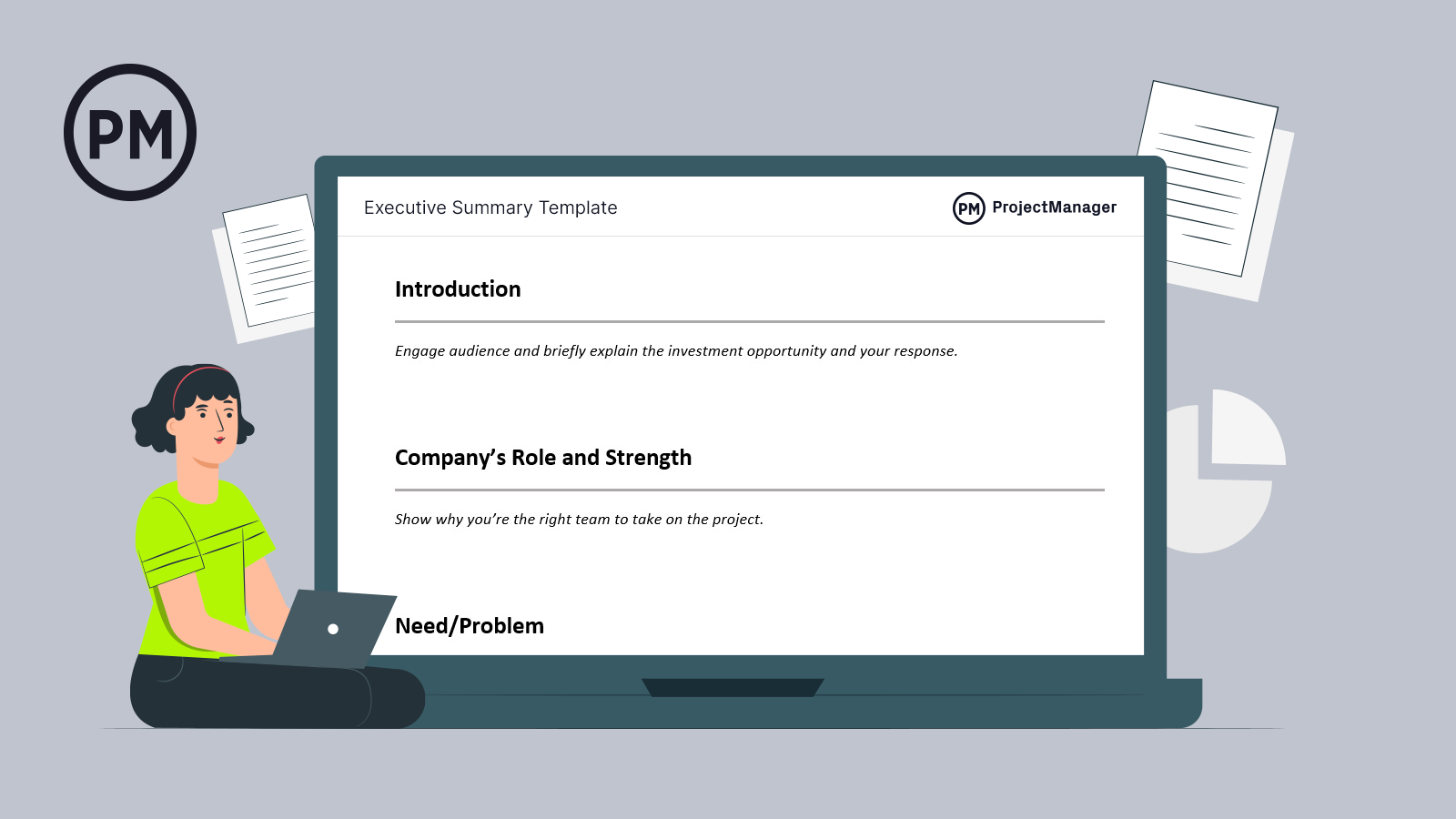
Get your free
Executive Summary Template
Use this free Executive Summary Template to manage your projects better.
Get the template
Benefits of Writing an Executive Summary
An executive summary offers several benefits as it’s an important part of any report, plan or proposal. We’ve outlined some key advantages.
- Offers a brief yet all-encompassing overview that helps readers understand key information quickly
- Improves communication, especially of complex ideas, to help stakeholders grasp key points
- Engages readers and helps them want to explore the whole document
- Helps stakeholders make informed decisions
- Aligns the project’s goals and objectives by summarizing key messages
When to Write an Executive Summary
Executive summaries can only come once the main content document is complete. This can include a business plan, project proposals, strategic plans or research projects.
- Business Plans: Think of an executive summary as a way to invite readers to explore deeper into your plan. Ideally, an executive summary should be written once the main sections of the business plan are complete. This ensures that it properly and accurately portrays the most important elements.
- Project Proposals: The project proposal includes the project description, objectives, methodology, budget and timeline. As the key points are now understood, the executive summary can help summarize the main aspects of the proposal. This can also help when presenting the proposal to stakeholders or other project decision-makers.
- Strategic Plans: Finalize all sections of the strategic plan such as the mission, vision, objectives, strategies, action plans and performance metrics. From there, you’ll be able to write the executive summary to note the most important insights and provide recommendations based on the plan.
- Research Projects: Similarly, once the main aspects of your research projects or proposals are finished, be sure to finalize all sections such as the methodology, findings and conclusions. The executive summary should be written last to extract the key findings and messages of the research you want to display.
What to Include in an Executive Summary
The content of your executive summary must reflect what’s in the larger document which it is part of. You’ll find many executive summary examples on the web, but to keep things simple, we’ll focus on business plans and project proposals.
Getting everything organized for your executive summary can be challenging. ProjectManager can help you get your thoughts in order and collaborate with your team. Our powerful task management tools make it easy to get everything prioritized and done on time. Try it free today.
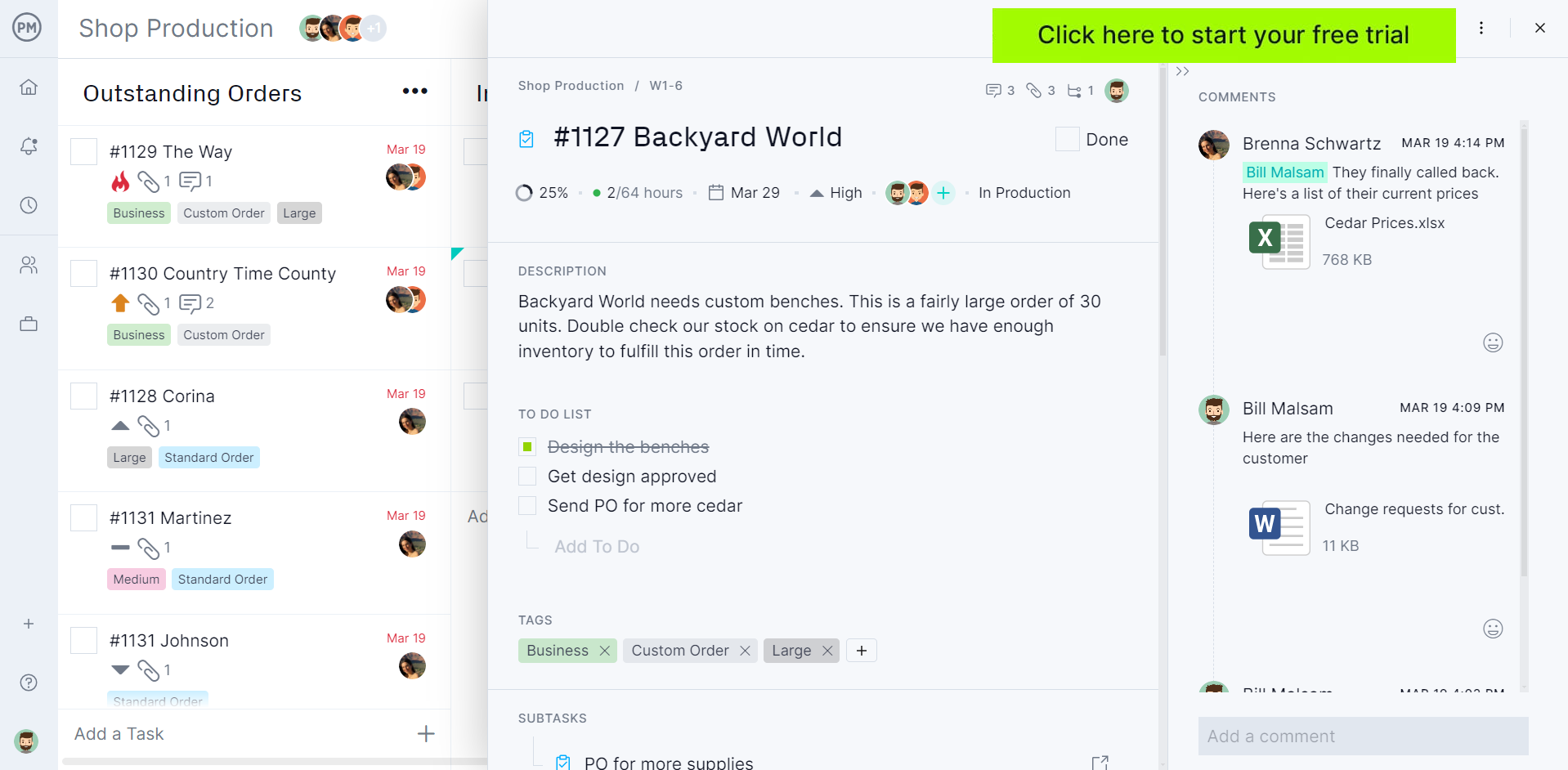
Sample Executive Summary Format & Template
To put all of that information together, here’s the basic format of an executive summary. You can find this same information in our free executive summary template:
- Introduction, be sure to know your audience
- Table of contents in the form of a bulleted list
- Explain the company’s role and identify strengths
- Explain the need, or the problem, and its importance
- Recommend a solution and explain its value
- Justify said solution by explaining how it fits the organization
- A strong conclusion that once more wraps up the importance of the project
You can use it as an executive summary example and add or remove some of its elements to adjust it to your needs. Our sample executive summary has the main elements that you’ll need project executive summary.
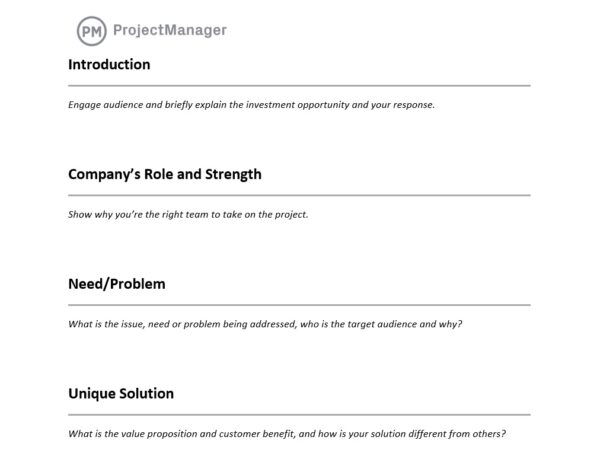
How to Write an Executive Summary
The pressure of writing an executive summary comes from the fact that everyone will pay attention to it, as it sits at the top of that heap of documents. It explains all that follows and can make or break your business plan or project plan. The executive summary must know the needs of the potential clients or investors and zero in on them like a laser. Fortunately, we’ll show you how to write and format your executive summary to do just that.
As stated above, executive summaries vary depending on the document they’re attached to. You can write an executive summary for a business plan, project proposal, research document, or business case, among other documents and reports. However, when writing an executive summary, there are guidelines to ensure you hit all the bases.
1. Establish the Length of the Executive Summary Length
According to the many books that have been written about executive summaries, as well as training courses, seminars and professional speakers, the agreed-upon length for an executive summary format should be about five to 10 percent of the length of the whole report.
2. Use the Appropriate Language
The language used should be appropriate for the target audience. One of the most important things to know before you write professionally is to understand who you’re addressing. If you’re writing for a group of engineers, the language you’ll use will differ greatly from how you would write to a group of financiers.
That includes more than just the words, but the content and depth of explanation. Remember, it’s a summary, and people will be reading it to quickly and easily pull out the main points.
3. Begin the Executive Summary with a Pithy Introduction
You also want to capture a reader’s attention immediately in the opening paragraph. Just like a speech often opens with a joke to break the tension and put people at ease, a strong introductory paragraph can pull a reader in and make them want to read on. That doesn’t mean you start with a joke. Stick to your strengths, but remember, most readers only give you a few sentences to win them over before they move on.
Don’t forget to explain who you are as an organization and why you have the skills, personnel and experience to solve the problem raised in the proposal. This doesn’t have to be a lengthy biography, often just your name, address and contact information will do, though you’ll also want to highlight your strengths as they pertain to the business plan or project proposal.
4. Only Include Relevant Information
The executive summary shouldn’t stray from the material that follows it. It’s a summary, not a place to bring up new ideas. To do so would be confusing and would jeopardize your whole proposal.
Establish the need or the problem, and convince the target audience that it must be solved. Once that’s set up, it’s important to recommend the solution and show what the value is. Be clear and firm in your recommendation.
Justify your cause. Be sure to note the key reasons why your organization is the perfect fit for the solution you’re proposing. This is the point where you differentiate yourself from competitors, be that due to methodology, testimonials from satisfied clients or whatever else you offer that’s unique. But don’t make this too much about you. Be sure to keep the name of the potential client at the forefront.
Don’t neglect a strong conclusion, where you can wrap things up and once more highlight the main points.
Related: 10 Essential Excel Report Templates
The steps above cover the basics of making an executive summary. However, the specific steps that you’ll need to take will vary depending on the type of document for which the executive summary is being prepared. Now, let’s go through the process of writing an executive summary for a business plan or a project proposal, along with some examples.
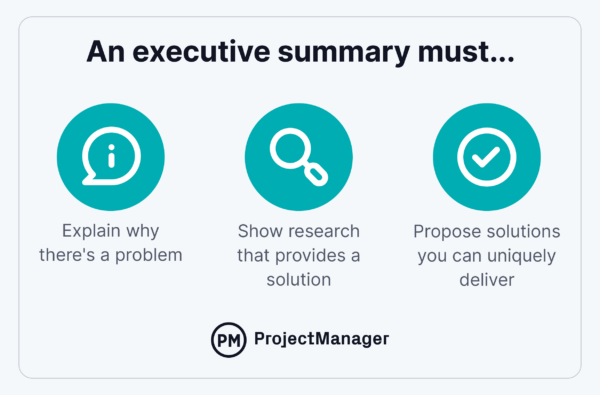
How to Write an Executive Summary for a Business Plan
As we’ve learned above, your executive summary must extract the main points of all the sections of your business plan. A business plan is a document that describes all the aspects of a business, such as its business model, products or services, objectives and marketing plan, among other things. They’re commonly used by startups to pitch their ideas to investors.
Here are the most commonly used business plan sections:
- Company description: Provide a brief background of your company, such as when it was established, its mission, vision and core values.
- Products & services: Describe the products or services your company will provide to its customers.
- Organization and management: Explain the legal structure of your business and the members of the top management team.
- SWOT analysis: A SWOT analysis explains the strengths, weaknesses, opportunities and threats of your business. They describe the internal and external factors that impact your business competitiveness.
- Industry & market analysis: This section should provide an overview of the industry and market in which your business will compete.
- Operations: Explain the main aspects of your business operations and what sets it apart from competitors.
- Marketing plan: Your marketing plan describes the various strategies that your business will use to reach its customers and sell products or services.
- Financial planning: Here, you should provide an overview of the financial state of your business. Include income statements, balance sheets and cash flow statements.
- Funding request: If you’re creating your business plan to request funding, make sure to explain what type of funding you need, the timeframe for your funding request and an explanation of how the funds will be used.
We’ve created an executive summary example to help you better understand how this document works when using it to sum up a business plan.
Executive Summary Example
For this executive summary example, we’ll imagine a company named ABC Clothing, a small business that manufactures eco-friendly clothing products and it’s preparing a business plan to secure funding from new investors.
Company Description
We are ABC Clothing, an environmentally-friendly manufacturer of apparel. We’ve developed a unique method of production and sourcing of materials that allows us to create eco-friendly products at a low cost. We have intellectual property for our production processes and materials, which gives us an advantage in the market.
- Mission: Our mission is to use recycled materials and sustainable methods of production to create clothing products that are great for our customers and our planet.
- Vision: Becoming a leader in the apparel industry while generating a positive impact on the environment.
Products & Services
We offer high-quality clothing products for men, women and all genders. (Here you should include pictures of your product portfolio to spark the interest of your readers)
Industry & Market Analysis
Even though the fashion industry’s year-over-year growth has been affected by pandemics in recent years, the global apparel market is expected to continue growing at a steady pace. In addition, the market share of sustainable apparel has grown year-over-year at a higher pace than the overall fashion industry.
Marketing Plan
Our marketing plan relies on the use of digital marketing strategies and online sales, which gives us a competitive advantage over traditional retailers that focus their marketing efforts on brick-and-mortar stores.
Operations
Our production plant is able to recycle different types of plastic and cotton waste to turn it into materials that we use to manufacture our products. We’ve partnered with a transportation company that sorts and distributes our products inside the United States efficiently and cost-effectively.
Financial Planning
Our business is profitable, as documented in our balance sheet, income statement and cash flow statement. The company doesn’t have any significant debt that might compromise its continuity. These and other financial factors make it a healthy investment.
Funding Request
We’re requesting funding for the expansion of our production capacity, which will allow us to increase our production output in order to meet our increasing customer demand, enter new markets, reduce our costs and improve our competitiveness.
If you’d like to see more executive summary examples for your business plan, you can visit the U.S. small business administration website. They have business plans with executive summary examples you can download and use.
Executive summaries are also a great way to outline the elements of a project plan for a project proposal. Let’s learn what those elements are.
How to Write an Executive Summary for a Project Proposal
An executive summary for your project proposal will capture the most important information from your project management plan. Here’s the structure of our executive summary template:
- Introduction: What’s the purpose of your project?
- Company description: Show why you’re the right team to take on the project.
- Need/problem: What is the problem that it’s solving?
- Unique solution: What is your value proposition and what are the main selling points of your project?
- Proof: Evidence, research and feasibility studies that support how your company can solve the issue.
- Resources: Outline the resources needed for the project
- Return on investment/funding request: Explain the profitability of your project and what’s in for the investors.
- Competition/market analysis: What’s your target market? Who are your competitors? How does your company differentiate from them?
- Marketing plan: Create a marketing plan that describes your company’s marketing strategies, sales and partnership plans.
- Budget/financial planning: What’s the budget that you need for your project plan?
- Timeline: What’s the estimated timeline to complete the project?
- Team: Who are the project team members and why are they qualified?
- Conclusions: What are the project takeaways?
Now that we’ve learned that executive summaries can vary depending on the type of document you’re working on, you’re ready for the next step.
Tips for Writing an Executive Summary
As with anything you write, you should always start with a draft. The first draft should hit all the marks addressed above but don’t bog yourself down in making the prose perfect. Think of the first draft as an exploratory mission. You’re gathering all the pertinent information. Once you’ve gathered all the relevant points in your executive summary draft, you can use an AI summarizing tool to filter the key ideas and refine the draft further.
Next, you want to thoroughly review the document to ensure that nothing important has been left out or missed. Make sure the focus is sharp and clear, and that it speaks directly to your potential client’s needs.
Proofread for Style & Grammar
But don’t neglect the writing. Be sure that you’re not repeating words, falling into cliché or other hallmarks of bad writing. You don’t want to bore the reader to the point that they miss the reason why you’re the organization that can help them succeed.
You’ve checked the content and the prose, but don’t forget the style. You want to write in a way that’s natural and not overly formal, but one that speaks in the manner of your target audience. If they’re a conservative firm, well then, maybe formality is called for. But more and more modern companies have a casual corporate culture, and formal writing could mistakenly cause them to think of you as old and outdated.
The last run should be proofing the copy. That means double-checking to ensure that spelling is correct, and there are no typos or grammatical mistakes. Whoever wrote the executive summary isn’t the best person to edit it, however. They can easily gloss over errors because of their familiarity with the work. Find someone who excels at copy-editing. If you deliver sloppy content, it shows a lack of professionalism that’ll surely color how a reader thinks of your company.
Criticism of Executive Summaries
While we’re advocating for the proper use of an executive summary, it’d be neglectful to avoid mentioning some critiques. The most common is that an executive summary by design is too simple to capture the complexity of a large and complicated project.
It’s true that many executives might only read the summary, and in so doing, miss the nuance of the proposal. That’s a risk. But if the executive summary follows the guidelines stated above, it should give a full picture of the proposal and create interest for the reader to delve deeper into the documents to get the details.
Remember, executive summaries can be written poorly or well. They can fail to focus on results or the solution to the proposal’s problem or do so in a vague, general way that has no impact on the reader. You can do a hundred things wrong, but if you follow the rules, then the onus falls on the reader.
ProjectManager Turns an Executive Summary Into a Project
Your executive summary got the project approved. Now the real work begins. ProjectManager is award-winning project management software that helps you organize tasks, projects and teams. We have everything you need to manage each phase of your project, so you can complete your work on time and under budget.
Work How You Want
Because project managers and teams work differently, our software is flexible. We have multiple project views, such as the kanban board, which visualizes workflow. Managers like the transparency it provides in the production cycle, while teams get to focus only on those tasks they have the capacity to complete. Are you more comfortable with tasks lists or Gantt charts? We have those, too.

Live Tracking for Better Management
To ensure your project meets time and cost expectations, we have features that monitor and track progress so you can control any deviations that might occur. Our software is cloud-based, so the data you see on our dashboard is always up to date, helping you make better decisions. Make that executive summary a reality with ProjectManager.
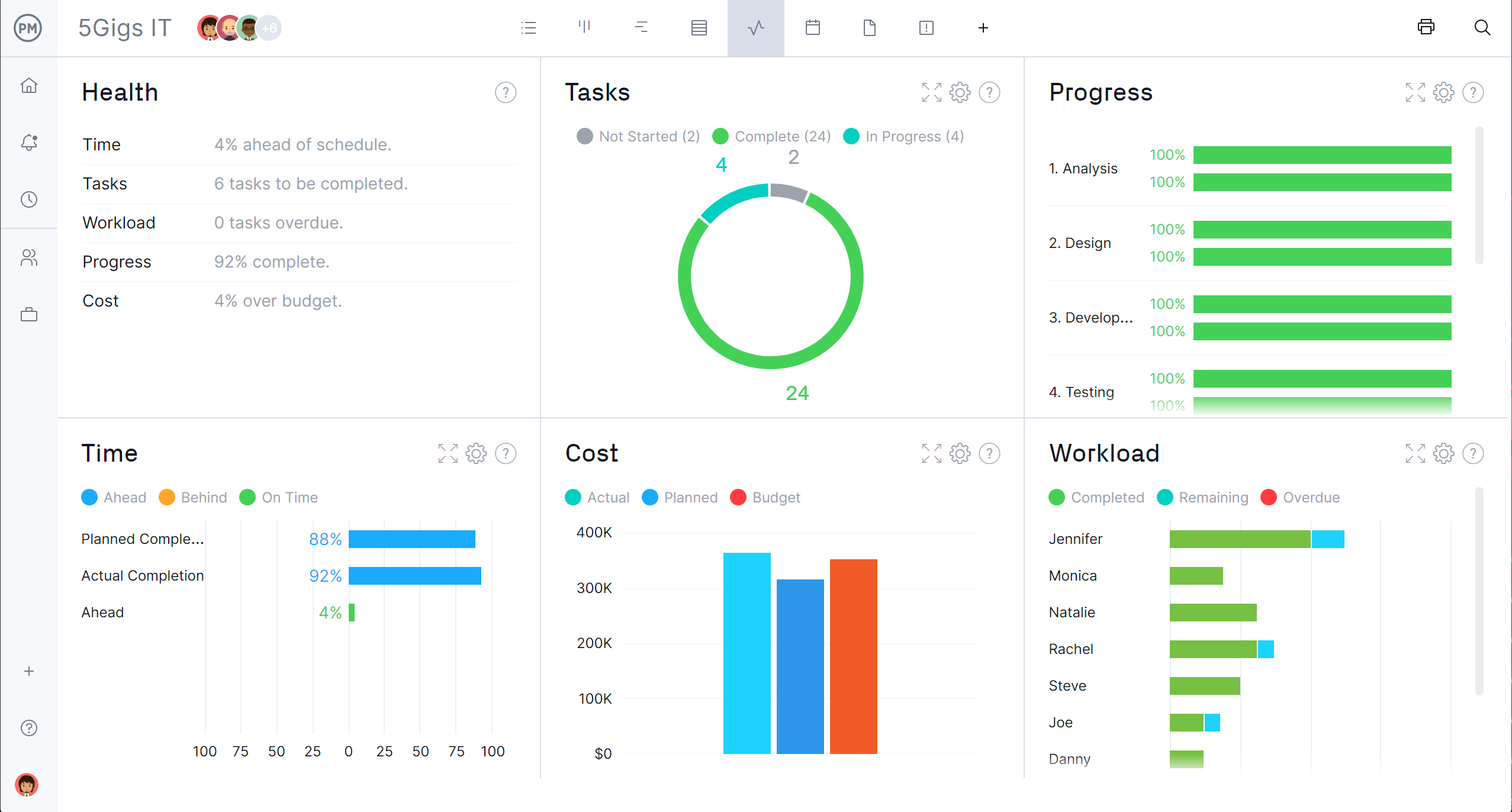
You’ve now researched and written a persuasive executive summary to lead your proposal. You’ve put in the work and the potential client sees that and contracts you for the project. However, if you don’t have a reliable set of project management tools like Gantt charts, kanban boards and project calendars at hand to plan, monitor and report on the work, then all that preparation will be for nothing.
Related Project Management Content
- 20 Essential Project Documents
- 10 Free Project Forms & Formats for Excel and Word
- 8 Project Plan Examples (Templates Included)
- Problem Statement Template
- Method Statement Template
- Executive Summary Template
- ¿Cómo escribir un resumen ejecutivo? guía rápida
ProjectManager is online project management software that gives you real-time data and a collaborative platform to work efficiently and productively. But don’t take our word for it, take a free 30-day trial.


